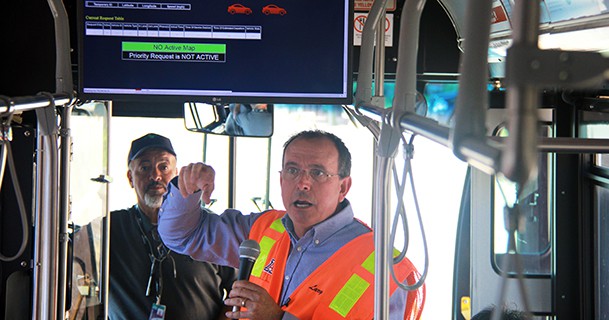 Researchers at the University of Arizona are working on systems for transportation to be part of the Internet of Things connections to vehicles to traffic lights, emergency vehicles and public transportation, allowing first responders to pass through first, while reducing traffic and pollution. The system uses DSRC radios that communicate between infrasructure and vehicles.
Researchers at the University of Arizona are working on systems for transportation to be part of the Internet of Things connections to vehicles to traffic lights, emergency vehicles and public transportation, allowing first responders to pass through first, while reducing traffic and pollution. The system uses DSRC radios that communicate between infrasructure and vehicles.
UA professor of systems engineering, Larry Head is researching Vehicle-to-infrastructure and vehicle-to-vehicle communications to change how traffic is managed and how drivers experience driving.
In March, Head and his graduate students took the Maricopa County Board of Supervisors, first responders, local, state and national transportation officials and high school students on a bus ride at the Arizona Connected Vehicle Test Bed to show them just what connected vehicles can do.
The 2.3-mile live stretch of road in Anthem, a Phoenix suburb, features Dedicated Short Range Communications radios, or DSRCs, mounted in demo buses and emergency vehicles, atop light poles, and in roadside equipment boxes at intersections. The wireless devices, developed by Savari Inc., work with traffic signal controllers developed by Econolite, both California-based companies. The equipment operates with optimization and scheduling algorithms developed by Head and his UA graduate researchers to manage the traffic signals in a revolutionary new way.
Along the test ride, the Valley Metro bus received messages from traffic signals, computed how long it would take to reach the signals, and sent requests for service back to the signals.
Using UA algorithms, the signals prioritized approaching vehicles — passenger, transit, emergency and commercial. At one intersection, a fire truck responding to a 911 call — for which an icon flashed on a monitor mounted in front of the bus before the emergency vehicle roared up — got the green light first. The monitor also alerted the bus of upcoming construction and school zones.
Working with researchers from the California Partners for Advanced Transportation Technology, or PATH, program, Head’s team enabled communication not just between traffic lights and emergency vehicles, but with many other vehicles as well. They also made it possible for all of the vehicles to communicate in real time. There are approximately 30,000 crashes involving fire trucks in the United States each year, and fire truck crashes are the second leading cause of death among firefighters.
Cars equipped with DSRCs can alert drivers to hazards up to few hundred meters away, out of their line of sight — a car slipping on ice around a curve or an oncoming car without headlights, for example.
Connected cars should start rolling out next year, and Head predicts national and state laws requiring DSRC will soon follow, as the public safety benefits become apparent. In addition to saving lives, connected roadway infrastructure and vehicles can reduce congestion and pollution.
Head is pursuing funding for the project’s third phase, to include putting DSRCs in up to 20 percent of vehicles used by Anthem residents.
Another part of Phase 3 involves putting DSRCs in freight trucks that travel on a stretch of Arizona State Route 85 in an industrial area of Phoenix.